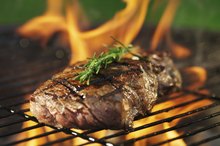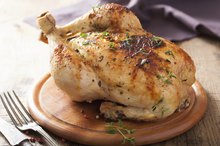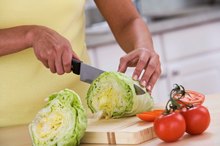Nutrition Information on Boston Butt Pork Shoulder
You might enjoy the flavor and moistness of shoulder cuts of pork, but part of that flavor and moistness comes from its high fat content. The Boston butt pork shoulder is a highly marbled meat most often used to make pulled pork. Knowing the nutrition information for this cut of meat can help you make adjustments to your diet for the occasional indulgence.
Calories
A 3.5-ounce serving of braised Boston butt pork contains 233 calories. The Boston butt pork shoulder makes a high-calorie meat choice when compared to other types of meat. By comparison, the same size serving of roasted chicken breast contains 165 calories. As a more calorie-dense food, the Boston butt cut of meat may not be the healthiest choice if you are trying to lose weight.
- A 3.5-ounce serving of braised Boston butt pork contains 233 calories.
- The Boston butt pork shoulder makes a high-calorie meat choice when compared to other types of meat.
Fat
Gyro Meat Nutritional Information
Learn More
The Boston butt pork shoulder is also higher in fat than other cuts of meat. A 3.5-ounce serving contains 13 grams of total fat and 5 grams of saturated fat, compared to 4 grams of total fat and 1 gram of saturated fat in the same serving of roasted chicken. Not only is the Boston butt higher in total fat, but it is also high in saturated fat, meeting 25 percent of your daily value. The percent daily value is based on a 2,000-calorie diet for healthy adults. Saturated fat in foods like the Boston butt raise blood cholesterol levels and your risk of heart disease.
- The Boston butt pork shoulder is also higher in fat than other cuts of meat.
- Not only is the Boston butt higher in total fat, but it is also high in saturated fat, meeting 25 percent of your daily value.
Protein and Carbohydrates
The Boston butt cut of meat is a good source of protein, and is carbohydrate-free. A 3.5-once serving of the braised meat contains 26 grams of protein, meeting more than 50 percent of your daily value for protein. In addition, as an animal source of protein, the Boston butt is a high-quality source of protein providing all of the essential amino acids. Your body uses amino acids in foods like pork shoulder to build the proteins found in your cells, organs and muscles.
- The Boston butt cut of meat is a good source of protein, and is carbohydrate-free.
- In addition, as an animal source of protein, the Boston butt is a high-quality source of protein providing all of the essential amino acids.
Vitamins and Minerals
Nutrients in Bologna
Learn More
While the Boston butt may be high in saturated fat, it is a good source of some of your essential vitamins and minerals. A 3.5-ounce serving contains 2 milligrams of iron, 5 milligrams of zinc, 4 milligrams of niacin, 1 microgram of vitamin B12 and 45 international units of vitamin D. One serving of the braised pork meets 35 percent of your daily value for zinc. Zinc is an essential mineral necessary for wound healing and immune health.
Related Articles
References
- Cook's Thesaurus: Pork Shoulder Cuts
- Centers for Disease Control and Prevention: Low-Energy-Dense Foods and Weight Management
- American Heart Association: Know Your Fats
- Pork, fresh, loin, tenderloin, separable lean only, cooked, roasted. FoodData Central. U.S. Department of Agriculture. Published April 1, 2019.
- Pork steak or cutlet, broiled or baked, lean only eaten. FoodData Central. U.S. Department of Agriculture. Published April 1, 2019.
- Pork, fresh, ground, cooked. FoodData Central. U.S. Department of Agriculture. Published April 1, 2019.
- Pork chop, broiled or baked, lean and fat eaten. FoodData Central. U.S. Department of Agriculture. Published April 1, 2019.
- Pork chop, broiled or baked, lean only eaten. FoodData Central. U.S. Department of Agriculture. Published April 4, 2019.
- Pork chop, breaded or floured, fried, lean and fat eaten. FoodData Central. U.S. Department of Agriculture. Published April 4, 2019.
- Pork sausage. FoodData Central. U.S. Department of Agriculture. Published April 4, 2019.
- Pork bacon, smoked or cured, cooked. FoodData Central. U.S. Department of Agriculture. Published April 4, 2019.
- Pulled pork. FoodData Central. U.S. Department of Agriculture. Published April 4, 2019.
- Spam, Classic Spam. FoodData Central. U.S. Department of Agriculture. Published April 4, 2019.
- Naseeb MA, Volpe SL. Protein and exercise in the prevention of sarcopenia and aging. Nutr Res. 2017;40:1-20. doi:10.1016/j.nutres.2017.01.001
- American College of Allergy, Asthma and Immunology. Meat allergy. Updated May 8, 2019.
- Turesky RJ. Mechanistic evidence for red meat and processed meat intake and cancer risk: A follow-up on the International Agency for Research on Cancer Evaluation of 2015. Chimia (Aarau). 2018;72(10):718-724. doi:10.2533/chimia.2018.718
- Djurković-Djaković O, Bobić B, Nikolić A, Klun I, Dupouy-Camet J. Pork as a source of human parasitic infection. Clin Microbiol Infect. 2013;19(7):586-94. doi:10.1111/1469-0691.12162
Resources
Writer Bio
Jill Corleone is a registered dietitian and health coach who has been writing and lecturing on diet and health for more than 15 years. Her work has been featured on the Huffington Post, Diabetes Self-Management and in the book "Noninvasive Mechanical Ventilation," edited by John R. Bach, M.D. Corleone holds a Bachelor of Science in nutrition.









